A snood is a stylish and at the same time warm accessory, for knitting of which double-sided patterns are often used.
Varying depending on the complexity of execution, they are distinguished by the same pattern on both sides, which gives the finished product a beautiful, voluminous look, and also makes it denser, resistant even to severe frosts.
Necessary tools
Double-sided patterns are considered by experts to be “universal” and are widely used when knitting a variety of snoods, scarves and hats.
Both sides of 2-way knitting look almost identical, and the finished product itself is quite dense, holds its shape well and retains heat without letting in cold air.
Often, 2-sided patterns are used when knitting snoods from thick, woolen, high-quality yarn that does not fray much.

Materials required for work:
| Yarn | The most convenient yarn for working with a 2-sided pattern is one containing up to 70-85% merino, angora or alpaca wool, with the obligatory addition of 10-15% nylon or polyester. It is used for knitting winter snoods-collars and tubes, it retains its shape well and does not fluff up, and the resulting product will provide maximum protection from cold wind and frost, being used as a scarf or hood. |
| Spokes | For knitting snoods, both circular (60-80 long) and straight knitting needles are suitable. In the latter case, the resulting product will simply have to be sewn along the edges. The diameter of the knitting needle should be 1-2 sizes smaller than the thread, which will give the pattern additional volume and relief. They are made of wood, bamboo or aluminum, while their surface must be smooth, without roughness and nicks. |
| Additional tools | · marker; · scissors; · notebook for notes; · thread with a needle. |
Master classes
A double-sided knitting pattern for a snood can be either very simple or complex and is divided by experts into several groups:
- Made with elastic bands - French, English, lush.
- The relief pattern is quite simple to make, but allows you to make the finished snood more voluminous and dense.
- Shadow pattern – refers to “universal” patterns and consists of front and back loops.
- With braids and arans - very difficult to perform and requires mandatory crossing of loops.

The choice of pattern depends on the skills and preferences of the master.
Pearl
The double-sided knitting pattern for a snood “Pearl” or “Rice knitting” requires the use of semi-woolen thick or medium-thick yarn (for example, Alize Lanagold, with a skein density of 100g/240 m).
The quantity will depend on the length and width of the product (on average, it will be 2 skeins for a snood 88 cm long in circumference and 44 cm wide).
You will also need the following for the job:
- knitting needles No. 5 or 6;
- scissors;
- marker.
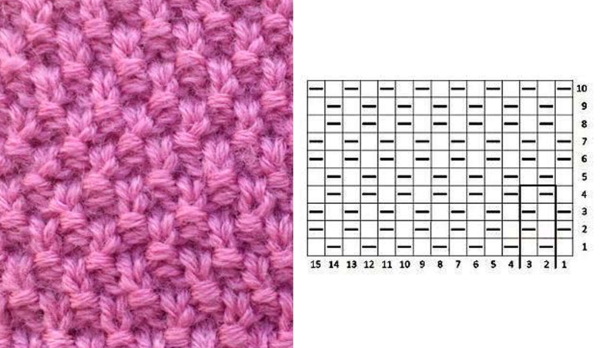
Pattern diagram:
| 1st row | 1 knit + 1 purl + 1 knit + 1 purl stitch. |
| 2nd row | 1 purl + 1 knit + 1 purl + 1 knit stitch. |
| In rows 3, 5, 7, 9, 11, 13 | Requires repeating the rapport of the 1st circle |
| In rows 4, 6, 8, 10, 14 | The pattern is knitted in the same way as on the 2nd circle. |
To work on the product you need:
- Cast on a number of stitches equal to the desired width of the scarf (e.g. 35-44) and knit with a pearl pattern, alternating front and back stitches in a row for 88 cm (approximately 125 rows).
- While working, strictly ensure that there is a purl loop above each front loop of the previous row and, conversely, a front loop above each back loop.
- As soon as the fabric reaches the desired length, close all the loops at the same time, cut the thread and hide it on the inside using a needle.
- Stretch the finished snood to size, moisten it and leave it until completely dry, and then connect the loops of the initial and final rows with a “loop in loop” stitch.
Swedish elastic
A snood scarf made with a double-sided pattern "Stockholm or Swedish rib" looks very impressive and is twisted in 2 turns around the neck. You can use medium-thick yarn for it (for example, PEH, with 50% merino wool and 50% acrylic), with a density of 50 g / 400 m.
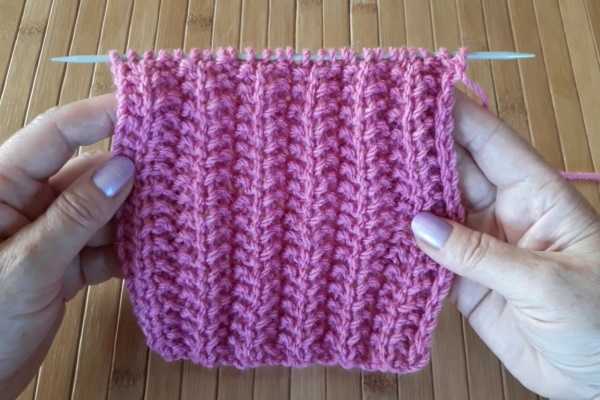
You will also need:
- circular knitting needles No. 6;
- scissors.
When working on a product you need to:
- Cast on a number of stitches divisible by 4 (for example, 128 or 252, when knitting a scarf measuring 95*35 cm in a circle) and do the following:
- in the 1st row, the pattern is 1 front and 1 back loop + 3 front and 2 back loops. It is repeated 8-12 times, and the row ends with 1 front and 1 back loop.
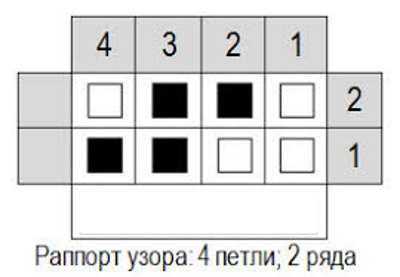
- 2nd circle with a pattern - with 1 front and 1 back loop + 1 front with a yarn over and a new front loop, after which you need to remove one of the loops without knitting, and then knit 2 back loops, pulled with a knitting needle through the removed loop.
The pattern is repeated 8-10 times, and the circle ends with 1 front and 1 back loop.
- in the 3rd row, the pattern is 1 front and 1 back + 2 front and 3 back loops. It should be finished in the same way as the 2nd round.
- in the 4th circle the pattern is 1 front + 1 back, without knitting you need to remove the loop, make 2 front loops after it, pulling them with a knitting needle through the removed loop. Then the rapport continues with 2 back loops and a yarn over. It ends the same way as the previous 3 circles.
- Repeating the patterns of rows 1-4 in sequence, knit the fabric to the desired length (for example, 35 cm), perform a one-stage closing of the loops and hide the ends of the threads.
If straight knitting needles were used for knitting, the halves of the snood will need to be sewn together.
"Rose hip"
The double-sided pattern for the snood "rosehip" includes 4 rows and 4 loops. It is knitted in turning rows or in a circle, thereby making the finished product denser and keeping the heat well. Thick or medium-thick yarn and knitting needles No. 5-6 are suitable for it.
During work you should:
Using knitting needles, cast on a number of loops divisible by 4, add 3 additional loops to it (one for the symmetry of the pattern and 2 edge loops) and do the following:
- 1st row with a rapport consisting of 3 front loops. The next loop after them must be removed, thrown onto the thread behind the work and knit 3 more front loops, and then a pattern repeating 5-7 times from one unknitted loop, removed onto the thread in front of the work and 3 front loops.
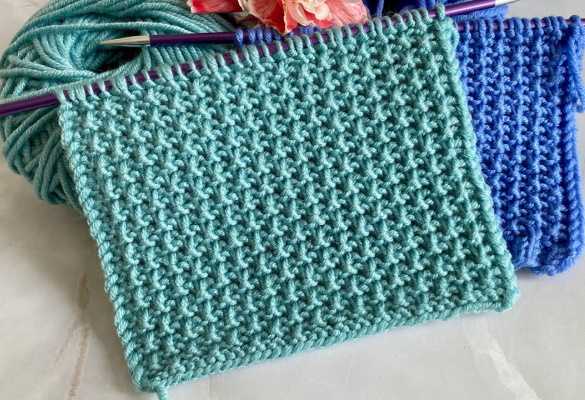
- In the 3rd row - a rapport of 1 front + one slipped stitch not knitted on the thread behind the work and 2 front loops. The rapport is knitted 4 times, and at the end of the row - 1 front loop is placed, followed by a loop slipped not knitted on the thread behind the work and 1 front loop.
- In the 4th row - 1 front loop + 1 loop removed onto a thread before work and 1 front loop, and then knit a rapport of 2 front loops 4 times, one of which must be removed without being knitted onto a thread before work and 1 front loop.
- Next, knitting the snood continues with constant repetition of the rapports of the 1st-4th circles.
When making the rosehip pattern on circular knitting needles, you need to cast on a number of loops also divisible by 4 and do the following:
- In the 1st repeat 5-7 times a pattern of 3 front loops. Remove one loop without knitting on the thread behind the work.

- In the 2nd row the pattern will be modified to 3 purl stitches, a slipped stitch on the yarn behind the work and 2 knit stitches.
- In the 3rd row, knit 5-7 times a pattern of 1 front loop, the next loop, slipped without knitting onto the thread behind the work and 2 front loops.
- 4th row – 1 purl + loop removed without knitting on the thread behind the work and 2 purl loops.
- Then the work continues with constant repetition of the rapports of the 1st-4th circles.
Embossed with diamonds
The embossed double-sided pattern with diamonds looks the same on both sides and has a distinct pattern that gives the finished product additional volume.
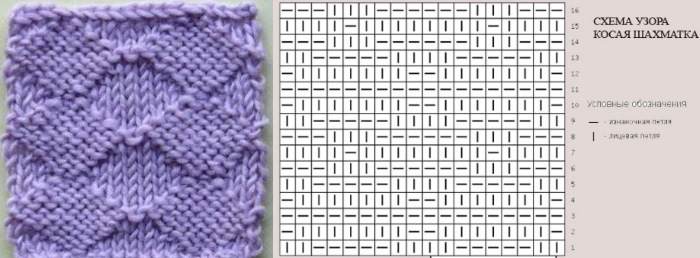
Ideal for knitting snoods and long scarves, it contains elements of rice knitting and can be combined into a set with items made with a pearl pattern.
For the rice pattern, you can use thick or medium-thick yarn (for example, Bebe Sheep, with 100% merino wool content) and No. 5 knitting needles.
The basis of the pattern is 8 loops and 28 rows, and to complete it you will need:
- Cast on a number of stitches divisible by 8 + 2 edge stitches located at the beginning and end of each circle and do the following:
- 1st row is a complete repeat of 1 purl and 1 front loop.

- Starting from the 2nd row, switch to knitting according to the pattern, for which in each even circle (4, 6, 8, 10 and so on) you should knit a knit stitch over each front loop, and a purl stitch over each back loop.
- 3, 5, 7, 9 and the remaining odd rows should be knitted exactly according to the rapport, which is repeated 8 times (until the end of the circle), and includes:
- in the 3rd circle - 1 front and 1 back loop + 2 front and 2 back loops + 1 front and 1 back loop.
- In the 5th row – 1 purl and 3 front loops + 3 purl and 1 front loop.
- In the 7th round, 4 front and 4 back loops are performed.
- In the 9th row – 3 front and 1 back loops + 1 front and 3 back loops.
- In the 11th row – 2 front and 1 back loop + 1 front and 1 back loop + 1 front and 2 back loops.
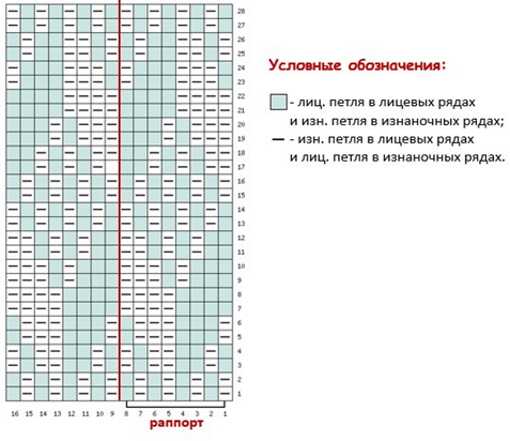
- The rapport of the 13th and 15th circles consists only of alternating one front and one back loop.
- In the 17th row – a pattern of 2 purl and 1 front loop + 1 purl and 1 front loop + 1 purl and 2 front loops.
- In the 19th row – a pattern of 3 purl and 1 front loop + 1 purl and 3 front loops.
- The 21st circle repeat consists of 4 knitted front and back loops.
- In the 23rd row – a rapport of 1 front and 3 back loops + 3 front and 1 back loop.
- In the 25th circle, repeat 6-8 times - 1 purl and 1 front + 2 purl and 2 front + 1 purl and 1 front loop.
- Row 27 is done entirely with 1*1 elastic (alternating front and back loops).
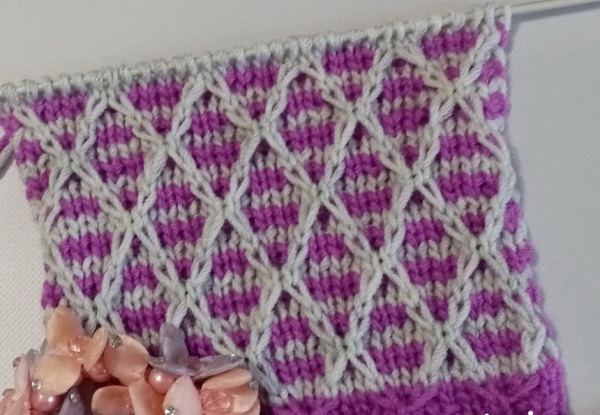

- Starting from the 29th circle, the pattern must be knitted from the beginning, placing the rapport of the 1st circle into it.
- Alternating rows and forming diamonds, you need to knit the snood to the desired length (for example, 30-40 m) and perform simultaneous closing of loops.
- Cut the thread and hide it on the inside, carefully pulling it through with a needle.
You can knit a snood with a relief pattern of diamonds in a circle or as a whole piece. In the latter case, after closing all the loops, it will need to be carefully sewn along the edge.
"Wave"
The relief, double-sided pattern "Wave" involves creating wave-like arcs decorated with openwork paths. For knitting it, medium-thick wool or semi-wool yarn (for example, YarnArt Alpine Angora) and knitting needles No. 3-5 are used.
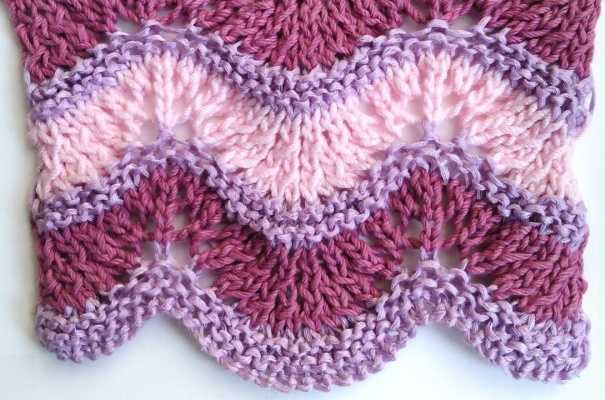
To complete the pattern you will need:
- Cast on a number of stitches divisible by 11, adding 2 edge stitches placed at the end of each row. When knitting in the round, one more extra stitch is added to them.
- Start working on the drawing by doing the following:
- Repeating 5-7 times the rapport of the 1st row of 2 loops knitted together through the back wall, followed by 3 knit loops + yarn over + 1 knit loop and yarn over + 3 knit loops and 2 loops knitted together through the front wall also with knit loops.
- The following rows 2, 4, 6, 8, 10 will consist only of purl stitches.
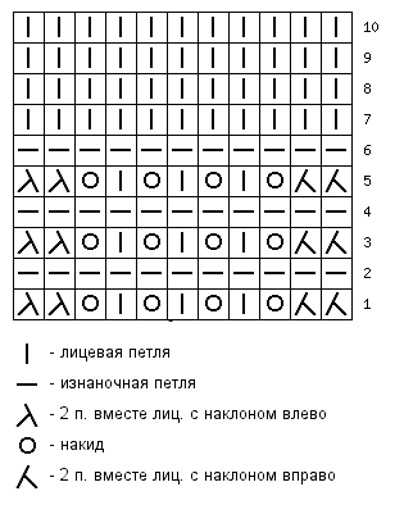
- Complete rows 3, 5, 7, 9 exactly as in round 1.
- Knit rows 11 and 13 entirely with purl stitches, and rows 12 and 14 with only knit stitches.
- The Wave pattern consists of 14 rows. You need to start repeating it from the 15th row. This should be done until the scarf reaches the desired length.
- In the resulting product, close all the loops at the same time, cut the thread and hide it on the wrong side.
- If the snood was knitted as a single piece (not in a circle), it will need to be sewn along the edges.
Pattern diagram:
| ·
| — knit stitches in the front row and purl stitches in the back row;
— purl stitches in the front row and front stitches in the back row; - 2 loops together, knitted. They are picked up from above (from the front). - 2 stitches knitted together with a pick-up stitch from below (behind the needle). — yarn over. It is done to create an openwork pattern by grabbing the working thread with the end of the right knitting needle from below, to the right and to the left towards you. | 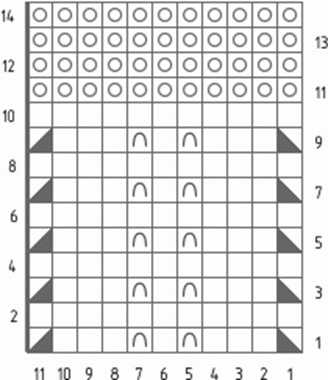 |
Body wave
One of the varieties of the "relief wave" is the "Volumetric Wave" pattern, made only from thick wool yarn (for example, Troitskaya from 100% sheep wool). You will also need knitting needles No. 5-6 for work.
The pattern rapport consists of 8 rows and 11 loops, and to make the snood you will need:
- Cast on a number of stitches on the knitting needles that is divisible by 11 + 3 stitches (for the symmetry of the pattern and edge stitches) and do the following:
- In the 1st row, only purl stitches.
- In the 2nd row – only front loops.
- In the 3rd row, begin to perform a repeating pattern 6-8 times per circle of 1 front loop + yarn over (made away from you) + 1 front loop with yarn over + 1 front loop and 6 times knitted front loop with double yarn over (towards you).
The rapport ends with 1 knit stitch with a yarn over knitted twice. It ends with a knit stitch.
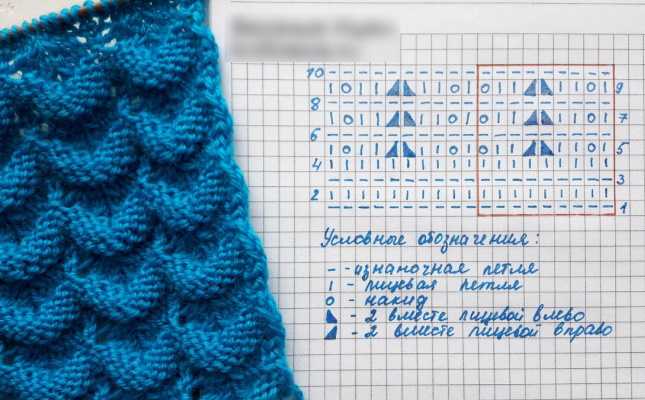
- In the 4th row there is a rapport of 5 purl loops, after which 6 double loops are removed onto the thread in front of the work, and an additional 4 front loops are knitted.
- In the 5th row, the pattern consists of 5 front loops + 6 loops knitted together with front loops through the back and front walls and 4 front loops.
- In the 6th and 8th rows, only purl stitches are knitted.
- Row 7 consists entirely of knit stitches.
- Starting from the 9th row, the pattern will need to be repeated from the beginning until the fabric reaches the required length.
- When finishing work on the snood, you need to simultaneously close all the loops and sew the ends of the fabric.
French (Polish) elastic
The double-sided pattern for the snood "French" or "Polish elastic" is knitted from medium-thick wool yarn (for example, Lana Gold Fine Alize), and its vertical relief has a zigzag shape. It is best to take knitting needles No. 3 or 3.5 for work.
Pattern diagram:
| 1st row | 1 purl stitch + 2 repainted stitches + 1 purl stitch |
| 2nd row | 1 knit + 2 repainted loops + 1 knit |
| 3, 5,7, 9 and other odd rows | knitted according to the rapport of the 1st row |
| 4, 6, 8 and all even rows | must repeat the pattern of the 2nd row |
To knit a snood using the French elastic pattern you will need:
- Cast on a number of stitches on the knitting needles that is divisible by 3, adding 1 stitch to it for the symmetry of the pattern and 2 edge stitches placed at the beginning and end of each row, and then do the following:
- In the 1st row after the edge stitch - 1 purl stitch and 2 crossed stitches, while you first need to knit the second stitch on the left knitting needle behind the back wall, and then the first stitch with the right knitting needle behind the back wall and drop them from the left knitting needle.
Then the rapport continues with 1 purl stitch. The pattern is repeated 6-8 times.
- In the 2nd row after the edge, place first the front loop, and then 2 crossed ones, while first you need to knit the second loop with the left knitting needle behind the front wall of the back, and then also the first, but with the right knitting needle. The pattern of the second row is completed with a front loop.

- Proceeding in a similar manner, you need to knit 30-40 cm of snood, and as soon as it reaches the desired length, close all the loops at the same time.
- Sew the ends of the product with a blind stitch and hide the remaining ends of the threads inside.
"Tourniquets"
Cables are often used for knitting scarves and snoods. They look the same on both sides and are based on knitting a 2*2 elastic band (alternating 2 front and back loops) with a tilt.
They look most advantageous on items made of thick wool yarn (for example, Gazzal Pure Wool, with 100% English wool). You will also need knitting needles No. 5-6 for work.


When working on a product you need to:
- Cast on a number of loops that is a multiple of 12 and add 4 more loops to this number (2 edge loops and 2 for symmetry) and knit:
- 1st row with 2*2 elastic, alternating 2 front and 2 back loops in the rapport. The 3rd and 5th rows will need to be completed in a similar manner.
- 2nd round with rapport 2*2, consisting of 2 purl and 2 front loops. Work continues in a similar manner on the 4th and 6th rows.
- In the 7th row, remove the edge loop, after which knit 2 front and 2 back loops.
The next 8 loops need to be crossed with a tilt to the right, while 4 loops should be transferred to an additional knitting needle and brought back (yarn behind the work). The next 2 should be knitted as front loops, and after them place the completed front loop from the additional knitting needle.

- In a similar way, you can make a braid with a left tilt, for which in the 7th row you also need to transfer 4 loops to an additional knitting needle and place them on the front side.
Then knit the next loop as a front loop, and after it place the loops made as front loops from the additional knitting needle.
- The pattern then continues with alternating execution of the pattern of rows 1-7 until the product reaches the desired length.
- After this, all the loops should be closed at the same time, and the scarf itself should be sewn along the edge.
Tips for Beginners
Each master selects a variety of double-sided patterns for himself independently, focusing on his own skills. At the same time, professionals advise beginners to start practicing on the simplest ornaments, gradually complicating the work.
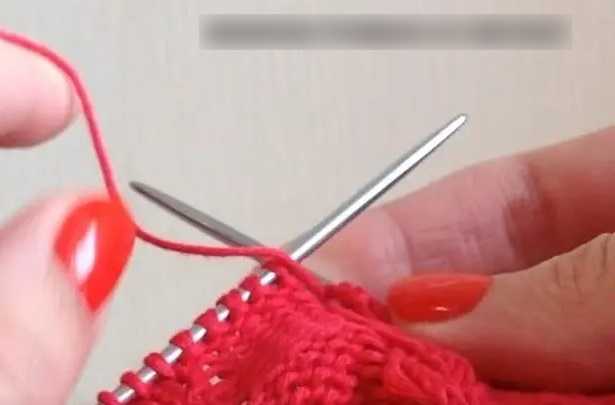
In addition, they recommend:
- When knitting, use only high-quality yarn made from wool with the addition of synthetic fiber. It is not recommended to save on its cost due to the high risk of purchasing a low-quality product, the finished product from which will quickly lose its shape.
- When making a double pattern, do not tighten the loops, making the snood very dense and at the same time increasing the yarn consumption. You need to hold the thread slightly taut, carefully pulling it towards you and not allowing it to hang loosely. Otherwise, the finished product will be very loose.
- Connect the ends of the snood with a neat, hidden stitch of the needle. When making such a stitch, you need to alternately grab a loop from each edge, without tightening the thread. This can be avoided by using circular knitting needles for knitting.
In this case, an additional loop is added to the number of loops specified for the pattern, which is used to join into a circle.

- Be sure to use a marker when knitting, marking the beginning and end of the rapport. It will also come in handy if you need to temporarily put the work aside, not allowing yourself to get confused.
- Buy a special notebook and write down in it all the selected patterns, increases and decreases, as well as the brand and size of the purchased yarn.
Double-sided patterns are a popular knitting pattern for snoods, as well as complementary hats and gloves, looking the same on both sides.
Adding visual volume and density to the finished product, they look most advantageous on products made from thick or medium-thick yarn, and vary depending on the complexity of the execution, while it is recommended to always take knitting needles 1 size smaller than those suggested by the manufacturer.
Video about knitting
Double-sided knitting pattern for a snood:
